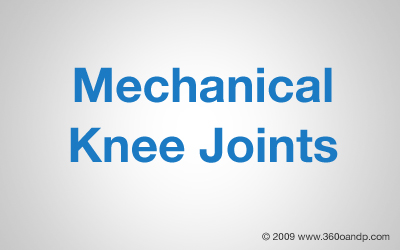
The anatomical knee has a changing axis of rotation and mechanical joints that have a fixed axis cannot move in complete unison with it. Therefore, some shifting of the orthosis relative to the limb occurs during flexion and extension of the knee. This can be minimized by 0proper placement of the mechanical knee joints.
FREE MOTION KNEE JOINT
The free motion knee joint allows unrestricted flexion and extension, but ordinarily incorporates a stop that prevents hyperextension. It is used normally for the individual with a tendency toward recurvatum.
OFFSET KNEE JOINT
The offset knee joint is placed posterior to the uprights and tends to extend passively when weight is transmitted through the uprights. Thus, the knee can be stabilized during stance phase with a lock and is left free to bend during swing phase. This type of joint is negated when a knee flexion contracture exists.
LOCKING KNEE JOINTS
The droplock knee joint is the most common used to control flexion. Ordinarily, both medial and lateral joints are used with a lock. Dependent on activity level and weight, a lateral joint may suffice.
BAIL LOCK KNEE JOINT
The bail lock knee joint can be used when the patient may exhibit difficulty releasing the drop lock.
ADJUSTABLE KNEE JOINTS
The adjustable knee joint permits locking in almost any degree of flexion.
ASSOCIATED CONDITIONS
The proper knee joint mechanism should only be chosen or adjusted by your certified orthotist.
CARE
All maintenance and adjustments to knee joints will be performed by your certified orthotist.